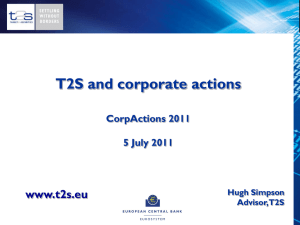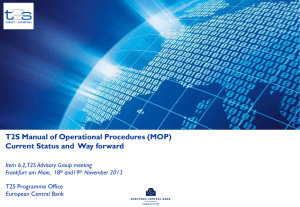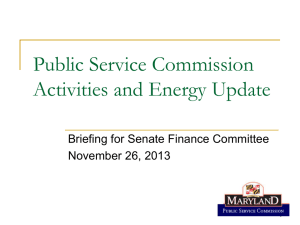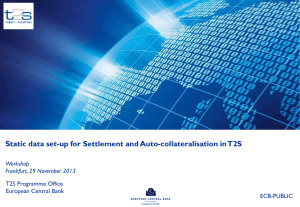View of the German NUG
advertisement
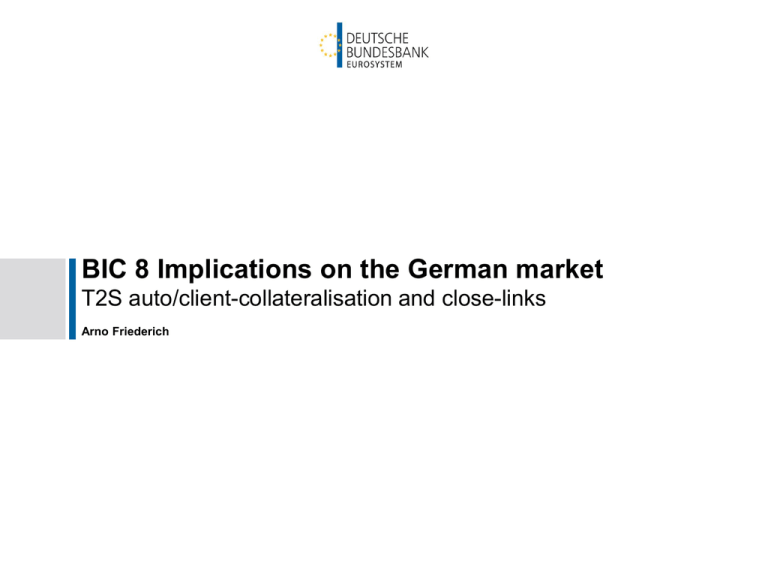
BIC 8 Implications on the German market T2S auto/client-collateralisation and close-links Arno Friederich Background of this presentation • Bundesbank has held a workshop for its market on the 19 November 2013 regarding • T2S auto-collateralisation and T2S client-collateralisation (including account setup in T2S (BIC8/11)) and • Close-links. • Participants were asked to present their views on the different topics • Bundesbank announced that it will use the input given for its presentation on the 29 November 2013 • A written consultation was launched afterwards for the full German market • Smaller banks were less concerned since this afflicts banks with a larger account setup There is a single market view Arno Friederich 13 April 2015 Page 2 Requirements of custodians and transaction banks • Current business models of custodian banks and transaction banks active domestic or in multiple T2S markets via branches and subsidiaries imply the following requirements given their current BIC codes: 1. 2. 3. 4. • Payment banks need to be able to monitor credit limits/ exposures via secondary CMBs in a so-called custodian model given the current BIC codes used for T2S Securities Accounts (SAC). Custodian banks with branches/ subsidiaries in several T2S markets require that T2S SACs of a branch/ business division not sharing the same BIC 8 code as the Dedicated Cash Account (DCA) holder, the payment bank, would need to benefit from autocollateralisation, and hence the SAC with a different BIC8 can be linked to the primary CMB as well. A transaction bank’s business model implies the need to link the SAC account to a DCA, both held by separate legal entities and hence different BIC8. The SAC should be linked to the primary CMB of the DCA in order to use auto-collateralisation. Flexible linkage of SACs to primary or secondary CMBs depending on the different business needs and the most cost efficient setup. The restrictions imposed by T2S on the configuration of the primary CMB setup definitely limits setup choices for custodians and transaction banks when using their current BIC8 codes as most of the above mentioned business cases are not feasible. Arno Friederich 13 April 2015 Page 3 Example for a Bank’s requirements for SAC-DCA Setup Currently not possible, workaround required Bank X SAC BANXFRPP123 + ESESFRPPXXX Bank X SAC BANXDEFFXXX + DAKVDEFFXXX Primary CMB Bank Y (subs) SAC BANYESMMXXX + IBRCESMMXXX Bank X SAC BANXDEFFCUS + DAKVDEFFXXX Secondary CMB1 Bank X branch SAC BANXBESMMCUS + IBRCESMMXXX Bank X SAC BANXDEFFCUS + MOTIITMMXXX Bank X SAC re Client A BANXDEFFXXA + DAKVDEFFXXX Secondary CMB2 Bank X SAC re Client B BANXDEFFXXB + DAKVDEFFXXX Secondary CMB3 Bank X SAC re Client C BANXDEFFXXC + ESESFRPPXXX Secondary CMB4 Client D SAC BANDDEFFXXX + DAKVDEFFXXX Secondary CMB5 Bank X SAC re Client E BANXDEFFXXE + DAKVDEFFXXX Primary CMB Arno Friederich 13 April 2015 Page 4 Bank X DCA Bank X T2 a/c BANXDEFFXXX + MARKDEFFXXX BANXDEFFXXX + MARKDEFFXXX Bank X requirements BIC code/ CMB allocation: — Different BIC 8 codes need to be linked to the same primary CMB — BIC 8 codes of DCA and SAC for primary CMB differ, but same legal entity — BIC 8 codes of DCA and SAC for primary CMB differ, due to two different legal entities (transaction bank model) — Different SACs with same BIC code to be linked to primary and secondary CMB — SACs held with different CSDs to be linked to same CMB/ DCA — Certain SACs linked to separate CMBs (for segregated accounts and clients‘ own CSD accounts) Not possible according to current T2S BIC code/ primary CMB restrictions Bank E DCA Bank E T2 a/c BANEDEFFXXX + MARKDEFFXXX BANEDEFFXXX + MARKDEFFXXX Potential workaround solutions identified by German banks • Two potential workarounds have been identified: 1. Open additional DCAs for liquidity management of specific clients 2. Eliminates liquidity pooling on a single DCA and is diametrically opposed to the idea of T2S Change of BIC8-codes to identify the CSD T2S party: a. Use client BIC8 codes for legal SACs of the custodian/ transaction bank (T2SCC) b. Allocate the BIC8 of the parent company to braches and subsidiaries (T2SAC) c. Apply for a new BIC8 code (e.g. a “connected” or “non-connected” BIC code which is then allocated to all SACs linked to CMBs of the DCA). In all cases the technical sender could use a different connected BIC8 e.g. “BANKDEFF” for messaging in the SWIFT network • Given the current BIC8 constraints for primary CMBs, these workarounds would force market participants (1) not to pool liquidity in a single DCA or (2) to change their BIC code setup due to coding as foreseen in the T2S-documentation. Arno Friederich 13 April 2015 Page 5 Drawbacks of the workarounds according to German banks • • • • • • • • • • • Banks may be forced to use several DCAs and hence cannot benefit from cash pooling on a single DCA Banks are forced to change their current BIC code setup Significant operational burden/ costs for banks for application of new BIC codes, change of static data and information of counterparties Change of CSD static data is required SWIFT costs of a new BIC8/ related BIC11 codes and time of availability (all bank requests coming at the same time depending on migration wave?), SWIFT approval required All T2S CSDs need to accept this special use of BIC codes, response is pending No distinct mapping of BIC8 codes to legal entities/ account owners Potential liability issues and low acceptance in light of regulatory transparency requirements Discrimination of business models of custodians and transaction banks Market participants pay for the development costs of the CMB functionality via the T2S fees but cannot utilize it adequately due to coding as foreseen in the T2Sdocumentation Additional T2S fees (e.g. client collateralisation) in the absence of a flexible BICCMB setup Arno Friederich 13 April 2015 Page 6 Requirements of German custodians and transaction banks • Support CR 429 for implementation in the first T2S release. • At least it should be implemented for a second release, any time later is not acceptable • Due to possible future mergers and acquisitions implementation of CR is necessary. • The then implemented workaround-solution account setup might be kept (partially) due to high implementation costs. => implemented CR 429 would • completely remove the restrictions on BICs for CMBs, • provide sufficient flexibility to support the needs of all market participants in their respective business models, • allow full cash-pooling, one of the major advantages of T2S, without restrictions. Arno Friederich 13 April 2015 Page 7 Close-links database in T2S Impact of BIC 8/11 issue Arno Friederich 13 April 2015 Page 8 Current Situation regarding close-links in T2S • Close-links in T2S have to entered in an ISIN-BIC11 combination • The ISIN has to have a close-link to or is directly issued by the relevant CSD participant identified by the BIC11 in T2S • Close-link data entered by any NCB is applied to every other NCB and payment bank • Payment banks are technically not able to enter close-link data or use an individual close-link database There is no close-link database usage envisaged until the second release Arno Friederich 13 April 2015 Page 9 Possible change request For a future use, by either the NCBs for T2S auto-collateralisation or the payment banks for T2S client-collateralisation a change request is necessary and was already requested by the Italian NUG • The German market supports in general such a change request • The change request is requested for the second release of T2S • The German market needs to be consulted on the technical details of the proposed change request so market needs are adequately addressed • Payment banks need to be able to address their clients correctly Arno Friederich 13 April 2015 Page 10 BIC 8/11 implications • The workaround solutions might force banks to apply numerous BICs to their SACs • This applies especially to those wanting to offer T2S clientcollateralisation This might lead to a situation where a single legal entity has numerous CSD participants in T2S to be able to implement their necessary account setup Same applies for clients of payment banks • In this case Bundesbank would need to enter for one close-link of one ISIN and one legal entity several ISIN-BIC combinations in T2S • There would be the need for a detailed monitoring which BICs (nonconnected, connected, BICs of clients) are used on the CSDs side for which legal entity • Payment banks would need to follow a similar approach Arno Friederich 13 April 2015 Page 11



